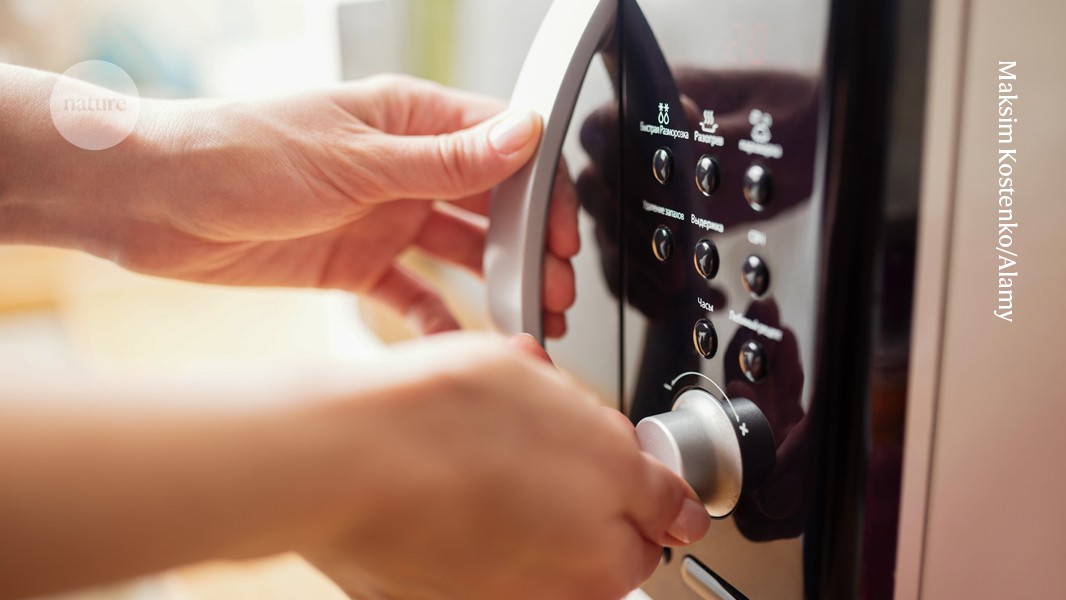Your microwave oven has its own microbiome

Survey of bacteria living inside household and laboratory appliances finds a robust ecosystem

After reading this story, you might want to clean your microwave oven.Credit: Maksim Kostenko/Alamy
‘Extremophiles’ are organisms that can survive, and even thrive, in the harshest of environments, including inside scorching hydrothermal vents, sub-zero Antarctic ice and the crushing pressures of Earth’s crust. Now, they’ve been discovered in a more pedestrian setting: microwave ovens.
Although previous studies found distinct communities of microbes in kitchen appliances such as dishwashers1 and coffee machines2, this is the first time that the microwave oven has been investigated for having its own microbiome. The research, published today in Frontiers in Microbiology3, adds to existing work challenging a common misconception: that microwave radiation heats up and completely kills bacteria that cause food-borne illness, such as Escherichia coli and Salmonella.
“We’ve all been taught, from like the 1980s, that if you use a microwave oven, it heats everything up — it kills everything,” says Jason Tetro, a freelance microbiologist, known as ‘The Germ Guy’, in Edmonton, Canada. This study is “important”, he says, because it shines a spotlight on potential pathogens in these appliances, especially shared ones.
All that’s zapped is not killed
Alba Iglesias, a microbiologist at the University of Valencia in Spain, and her colleagues swabbed 30 microwave ovens — including some in households; some shared in large spaces, such as offices; and some used in laboratories to heat specimens and chemical solutions. The team then cultured its samples in Petri dishes and determined the genera of the microbes that grew. They also sequenced the DNA in the material swabbed from the microwave ovens to get a sense of the bacterial diversity inside the appliances.
A total of 101 bacterial strains grew in the cultures. The dominant ones belonged to the Bacillus, Micrococcus and Staphylococcus genera, which commonly live on human skin and surfaces that people frequently touch. Human-skin bacteria were present in all three types of microwave oven, but were more abundant in the household and shared-use appliances. A few bacteria types associated with food-borne illnesses, including Klebsiella and Brevundimonas, also grew in some of the cultures from household microwaves.
Laboratory microwave ovens contained the greatest genetic diversity of bacteria. The researchers found both kitchen-counter bacteria and extremophiles that can withstand the radiation, high temperatures and extreme dryness in these appliances.
“You don’t need to go to very exotic — geographically speaking — places to find diversity of microorganisms,” says co-author Manuel Porcar, a microbiologist also at the University of Valencia in Spain.
The team suggests that the extremophile strains they found in the microwave ovens might have been ‘selected’ evolutionarily by surviving repeated rounds of radiation, and could have biotechnological applications, such as in the bioremediation of toxic waste. Porcar says that the next step is to investigate how microwave usage might affect these bacteria over time.
But for the general public, the implications of the study are simpler. “A microwave is not a pure, pristine place,” Porcar says. It’s also not a pathogenic reservoir to be feared, he says. But he does recommend cleaning your kitchen microwave often — just as often as you would scrub your kitchen surfaces to eliminate potential bacteria.
doi: https://doi.org/10.1038/d41586-024-02553-9
This story originally appeared on: Nature - Author:Alix Soliman


















